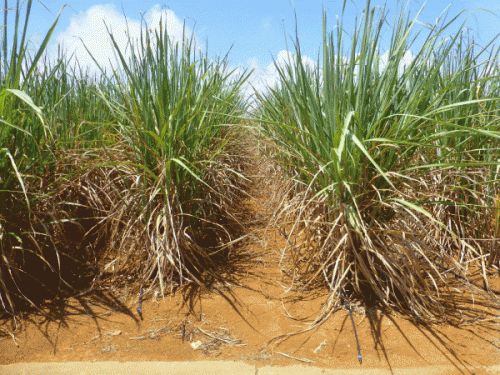Sugarcane fields take a hit from a dry rainy season, some villages consider rationing water

Part of sugarcane field showing cracks in the ground due to the effects of a dry rainy season on May 30 in Kitadaito
May 31, 2018 Ryukyu Shimpo
By Junko Uechi
Despite beginning its rainy season on May 8, the Okinawa region continues to see very little rain. There was only one day in which it rained heavily on the south-central part of the main island of Okinawa, and that was on May 21. Due to the effects of a dry rainy season that has lasted more than three weeks, the quantity of water in the dams has fallen below 27.1 units compared to regular years. In other words, it has decreased to 47.1 percent. On remote islands, since precipitation is significantly lower than regular years, it is greatly affecting the growth of crops, such as sugarcane. Some villages are considering rationing water. People from the tourist industry are also voicing their concerns about water shortage with the summer tourist season just around the corner.
Minamidaito, Tokashiki, and Zamami Villages continue to see very little rain even after entering the rainy season. The lack of rain has affected agriculture and daily life water supplies. With the expected increase in tourism ahead, some villages are contemplating rationing water.
April’s precipitation for Minamidaito Village was 13.0 millimeters, and as of May 29, May’s precipitation was 18.5 millimeters, making it the remote island near the main island with the lowest rainfall. As of May 25, the storage percentage of the 18 reservoir locations on the island was 28.2. Sugarcane are already in the midst of dying. The village’s Sugarcane Production Cooperative head Tsutomu Gima, 61, depressedly said, “The important period for sugarcane growth is between March and June.”
April’s precipitation for Kitadaito Village was at a historic low at 14.5 millimeters. As of May 29, May’s precipitation remained at about 30 millimeters. According to a village representative, on average, the water reservoir for agriculture has decreased to about 50 percent. The storage percentage of the reservoir in Kurobe area on the west side of the island is down to 10 percent. Katsuya Uechi, 57, said, “The yield will probably drop by about 50 percent. We’ll just have to wait for heavy rains or a typhoon.”
As of May 30, the storage percentage of the Zamami Dam in Zamami Village was 43.93 percent and 31.1 percent for Utaha Dam of Aka Island. While Zamami Island has a seawater desalination facility and Aka Island has a seawater desalination apparatus, since the number of tourists will increase starting late June, a village representative said, “We have no choice but to contemplate rationing water starting now.”
Even in Tokashiki Village, as of May 30, the storage percentage was below 36 percent. Normally, it is at about 80 percent, so there is a high probability that the village will take the plunge and ration water. While Aguni and Tonaki Villages are also witnessing less rain than normal years, according to representatives from both villages, they both have had a certain amount of precipitation where it is not significantly affecting agriculture and daily life water supplies.
Meanwhile, according to the Okinawa Meteorological Observatory, the seasonal rain front is advancing southward. According to the forecast, up to June 3, the main island of Okinawa area will be cloudy with intermittent rain. Up to June 4, Kitadaitou, Minamidaitou, Miyako, and Yaeyama areas are expected to be cloudy with occasional rain.
(English translation by T&CT and Chelsea Ashimine)
Previous Article:Representatives from soil source sites for land reclamation assert solidarity with Okinawa opposing Henoko construction
Next Article:Endangered Tern spotted in Henoko
[Similar Articles]
- Hateruma-jima sugarcane crops affected by biggest draught in 40 years
- The rainy season begins in Okinawa
- Long rainy season ends in Okinawa
- Okinawa is first in Japan to see end of rainy season
- Rainy season ends one week earlier than usual in Okinawa
 Webcam(Kokusai Street)
Webcam(Kokusai Street)


